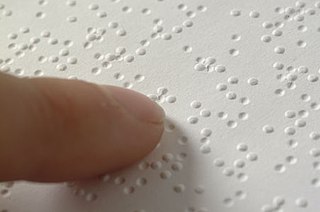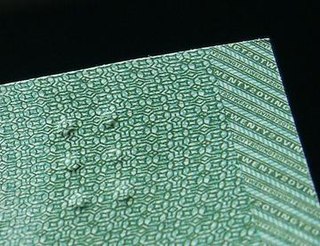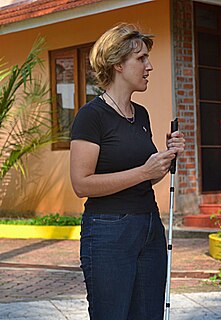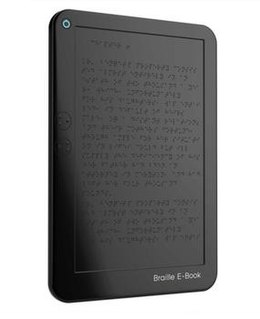
Braille is a tactile writing system used by people who are visually impaired, including people who are blind, deafblind or who have low vision. It can be read either on embossed paper or by using refreshable braille displays that connect to computers and smartphone devices. Braille can be written using a slate and stylus, a braille writer, an electronic braille notetaker or with the use of a computer connected to a braille embosser.

A refreshable braille display or braille terminal is an electro-mechanical device for displaying characters, usually by means of round-tipped pins raised through holes in a flat surface. Visually impaired computer users who cannot use a standard computer monitor can use it to read text output. Deafblind computer users may also use refreshable braille displays.

Louis Braille was a French educator and inventor of a reading and writing system for use by people who are visually impaired. His system remains virtually unchanged to this day, and is known worldwide simply as braille.

The Perkins Brailler is a "braille typewriter" with a key corresponding to each of the six dots of the braille code, a space key, a backspace key, and a line space key. Like a manual typewriter, it has two side knobs to advance paper through the machine and a carriage return lever above the keys. The rollers that hold and advance the paper have grooves designed to avoid crushing the raised dots the brailler creates.

Braille music is a braille code that allows music to be notated using braille cells so music can be read by visually impaired musicians. The system was incepted by Louis Braille.

The Canadian currency tactile feature is a feature on the Canadian Journey and Frontier series of Canadian banknotes to aid people who are visually impaired to identify the notes. The feature indicates the banknote denomination in the upper left corner of the face side of the bill using a series of raised dots. It was suggested by Bruno Thériault, an administrator for the Canadian National Institute for the Blind, and designed by Susan Lederman, a professor of psychology at Queen's University.
Unified English Braille Code is an English language Braille code standard, developed to permit representing the wide variety of literary and technical material in use in the English-speaking world today, in uniform fashion.
Braille ASCII is a subset of the ASCII character set which uses 64 of the printable ASCII characters to represent all possible dot combinations in six-dot braille. It was developed around 1969 and, despite originally being known as North American Braille ASCII, it is now used internationally.

Sabriye Tenberken is a German tibetologist and co-founder of the organisation Braille Without Borders.

(Mainland) Chinese Braille is a braille script used for Standard Mandarin in China. Consonants and basic finals conform to international braille, but additional finals form a semi-syllabary, as in zhuyin (bopomofo). Each syllable is written with up to three Braille cells, representing the initial, final, and tone, respectively. In practice tone is generally omitted as it is in pinyin.

Hebrew Braille is the braille alphabet for Hebrew. The International Hebrew Braille Code is widely used. It was devised in the 1930s and completed in 1944. It is based on international norms, with additional letters devised to accommodate differences between English Braille and the Hebrew alphabet. Unlike Hebrew, but in keeping with other braille alphabets, Hebrew Braille is read from left to right instead of right to left, and unlike English Braille, it is an abjad, with all letters representing consonants.
Braille technology is assistive technology which allows blind or visually impaired people to do common tasks such as writing, browsing the Internet, typing in Braille and printing in text, engaging in chat, downloading files, music, using electronic mail, burning music, and reading documents. It also allows blind or visually impaired students to complete all assignments in school as the rest of sighted classmates and allows them take courses online. It enables professionals to do their jobs and teachers to lecture using hardware and software applications. The advances of Braille technology are meaningful because blind people can access more texts, books and libraries and it also facilitates the printing of Braille texts.
A sighted child who is reading at a basic level should be able to understand common words and answer simple questions about the information presented. They should also have enough fluency to get through the material in a timely manner. Over the course of a child's education, these foundations are built on to teach higher levels of math, science, and comprehension skills. Children who are blind not only have the education disadvantage of not being able to see: they also miss out on the very fundamental parts of early and advanced education if not provided with the necessary tools.

Japan Braille Library is a special private library in Tokyo, Japan, serving individuals who are unable to read standard printed material, and those who research the field of visual impairment. JBL is one of the biggest and oldest libraries for the blind in Japan. The library's collection includes about 81,000 braille books, 210,000 talking books, and various documents concerning the blind and braille. JBL also provides a braille transcription service, a braille printing service, a recording service, digital library services, PC training programs, braille training programs, and sells about 1,200 products for the blind. The library's services now extend beyond Japan, providing braille textbooks and computer training to developing Asian nations.

The Braille Institute of America (BIA) is a nonprofit organization with headquarters in Los Angeles providing programs, seminars and one-on-one instruction for the visually impaired community in Southern California. Funded almost entirely by private donations, all of the Institute's services are provided completely free of charge. The organization has seven regional centers: Anaheim, Coachella Valley, Laguna Hills, Los Angeles, Riverside, San Diego and Santa Barbara, as well as outreach programs at more than 200 locations throughout Southern California. It is a member of the Braille Authority of North America.

The Mountbatten Brailler is an electronic machine used to type braille on braille paper. It uses the traditional "braille typewriter keyboard" of the Perkins Brailler with modern technology, giving it a number of additional features such as word processing, audio feedback and embossing. The machine was pioneered and developed at the United Kingdom's Royal National College for the Blind in Hereford by Ernest Bate.

English Braille, also known as Grade 2 Braille, is the braille alphabet used for English. It consists of around 250 letters (phonograms), numerals, punctuation, formatting marks, contractions, and abbreviations (logograms). Some English Braille letters, such as ⠡ ⟨ch⟩, correspond to more than one letter in print.
RoboBraille is a web and email service capable of converting documents into a range of accessible formats including Braille, mp3, e-books and Daisy. The service can furthermore be used to convert otherwise inaccessible documents such as scanned images and pdf files into more accessible formats. RoboBraille has been in operation since 2004 and currently serves thousands of user requests each month from users around the world. The service is available for free for strictly individual, non-commercial use. Institutional use by academic institutions is available through SensusAccess.

A braille e-book is a refreshable braille display using electroactive polymers or heated wax rather than mechanical pins to raise braille dots on a display. Though not inherently expensive, due to the small scale of production they have not been shown to be economical.
Irish Braille is the braille alphabet of the Irish language. It is augmented by specifically Irish letters for vowels that take acute accents in print:













